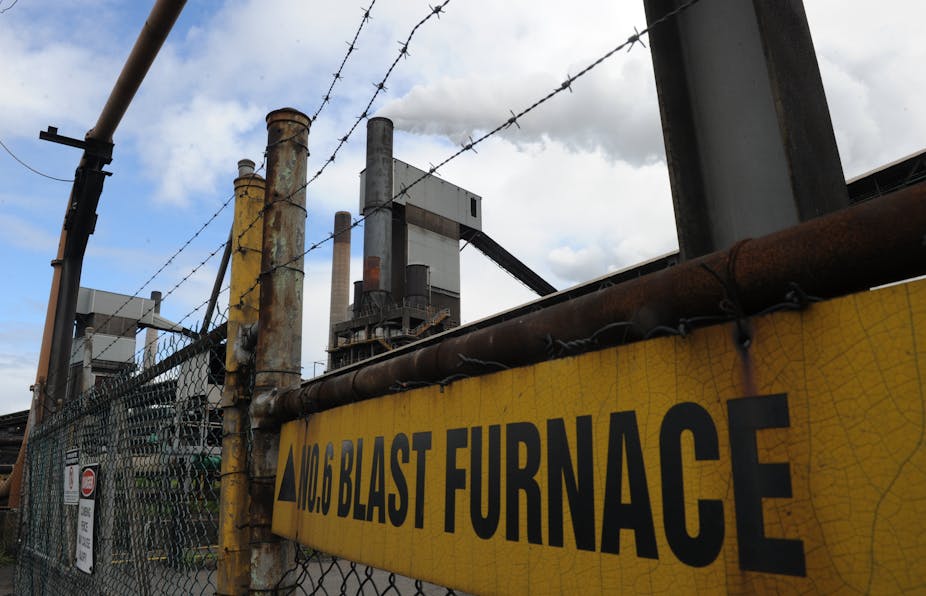Once upon a time, 30 years ago, when we still thought the steel industry was an endless and bottomless well for economic growth and employment, many of us also believed in industry policy, corporate responsibility to communities, and the right to stay in the same place and space as long as we wanted.
We were happily unaware that “restructuring” would become inevitably intertwined with “job losses” or that the inheritors of the Kingswood (which many of us drove back then) would soon be driving cars neither built in Australia nor made from Australian steel.
But that was 30 years ago. Shortly after, the Australian steel industry began to spin into crisis, an early home-grown casualty of the globalisation of production.
Indeed, the crisis should probably have happened sooner but in those days there was a fair investment in Australian steel production and the low Aussie dollar meant good steel export prices – the US even accused Australia of dumping cheap steel – and profit levels were generally accepted at lower rates than today.
Shock to the system
Even so, when it came, that first steel crisis was pretty shocking – postwar Australians were not yet used to major job losses, nor the allied multiplier effects that devastated towns and communities.
I remember writing in the introduction to the Katherine Thompson play, Diving for Pearls, (set in an industrial town experiencing major job losses) that Christmas 1982 was a time of fear and spending, as people avoided each other, fearful of hearing bad news or telling it, and spending up big because of redundancy pay – or fear of job loss.
Yet, sooner than we hoped, most of us bounced back. That was because they had a wonderful instrument in those days called industry policy.
In those distant decades, governments were not wedded to day trading for policies – they took longer term views, knew “the market” could be as mindless and destructive as Triffids, and also took it as their responsibility to intervene so the polity, society and economy were not mere flotsam among the blips and bumps of market fluctuations.
Industry plan
And that was the case in 1983 when the Steel Industry Plan (SIP) was proposed, debated and implemented over a few months.
The SIP was not just a comprehensive and integrated set of assistance, responsibilities, goals and gains for the steel stakeholders, it was even a tripartite policy (that is sooo 20th century!) and had the commitment of the steel company, the trade unions and communities, and the government. It worked – at least for a time.
Now again in 2011, we have a steel industry crisis. After reports of an annual loss of nearly $1 billion (nearly ten times the average profits of 20 years ago), 1000 redundancies and a major reduction of contractors have been announced at BlueScope Steel. The causes are fourfold.
Paradox
The most important factor has been the high Australian dollar – paradoxically driven by the resources boom – which has raised the price of steel exports.
The paradox is that the second factor leading to the current steel crisis has been increased input costs – notably iron ore and coal. The drivers of the very mining boom which has raised the Australian dollar have also raised the costs of production – coal prices for example have tripled in the last decade.
The effect of these factors has meant the crisis has been more pronounced on BlueScope, which has less favourable access to inputs than has its former sister company, OneSteel.
Third, there is pressure on steel companies throughout the developed world – the Brazilian company Usiminas is in trouble, and even ArcelorMittal, the biggest steel company of them all is struggling.
Market shift
Export markets are shifting. Japan is planning to buy steel for post-earthquake reconstruction from China or Korea, and many former customers of Australian steel are now exporters. And on top of all of that, in Australia, the fall of steel is tied to the inexorable decline of local manufacturing.
When manufacturing booms, steel bounces, but employment in manufacturing has fallen to well less than 10% of employment in the last decade, and its contribution to the national economy has fallen similarly.
So it is perhaps not surprising that we have another steel crisis. The job losses may be fewer and the impact on buyer, supplier and contractor firms may be less, but we have a steel crisis that will once again weaken and depress the steel communities of the Illawarra. Brave words are being spoken of resilience and hope, but the options in steel are few.
Anti-competitive
Certainly we won’t have a Steel Industry Plan this time around – the WTO has put paid to that. Giving preference to local product for construction is now “anticompetitive”, and so are tariffs and subsidies.
Governments can support the steel communities – at least a little – but they cannot support the steel industry, they cannot offer carrots to encourage capital investment or enforce requirements on major new projects to buying Australian made products.
They can ask nicely, but in the brave new world of free trade, governments are tied to the higgling of the market.
Chillingly, perhaps the story books of the future might begin – “Once upon a time, when Australia had a steel industry …”

